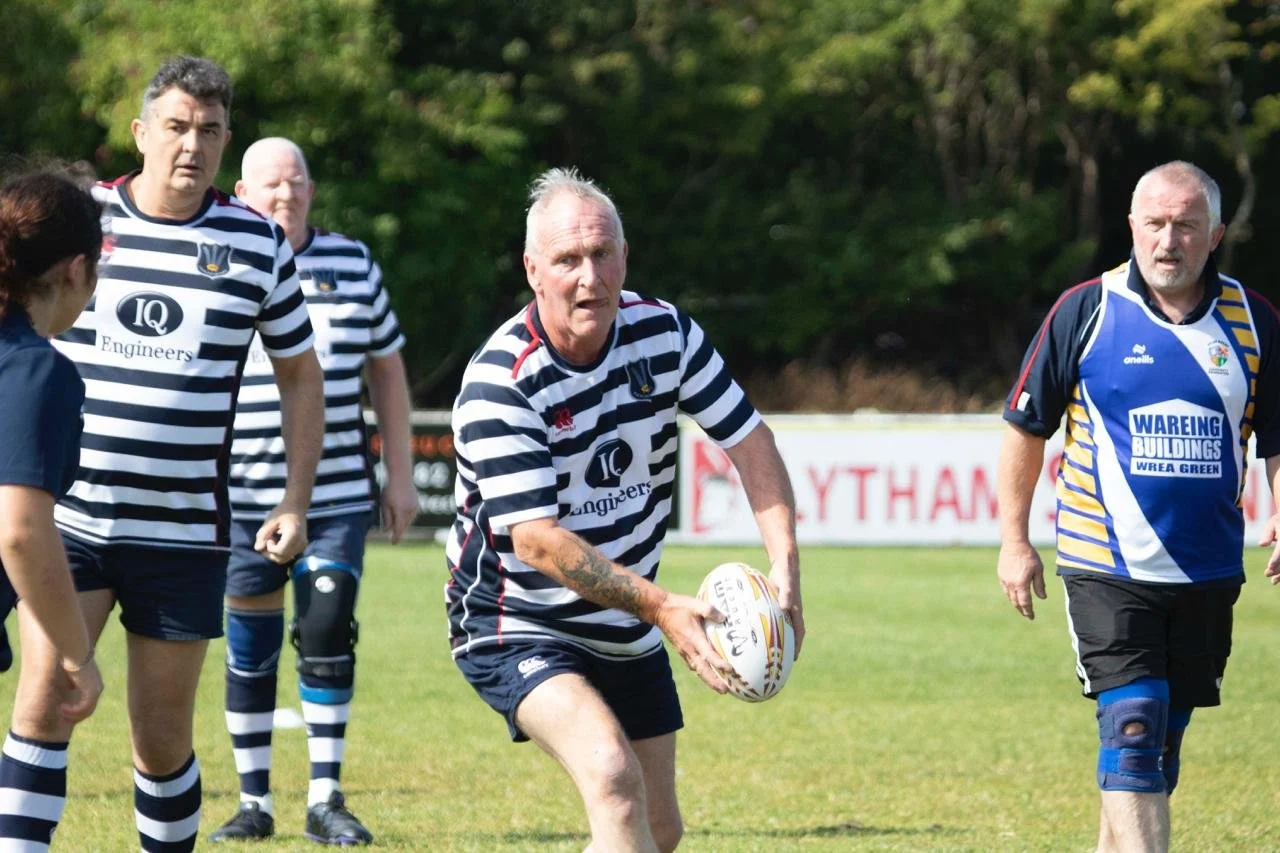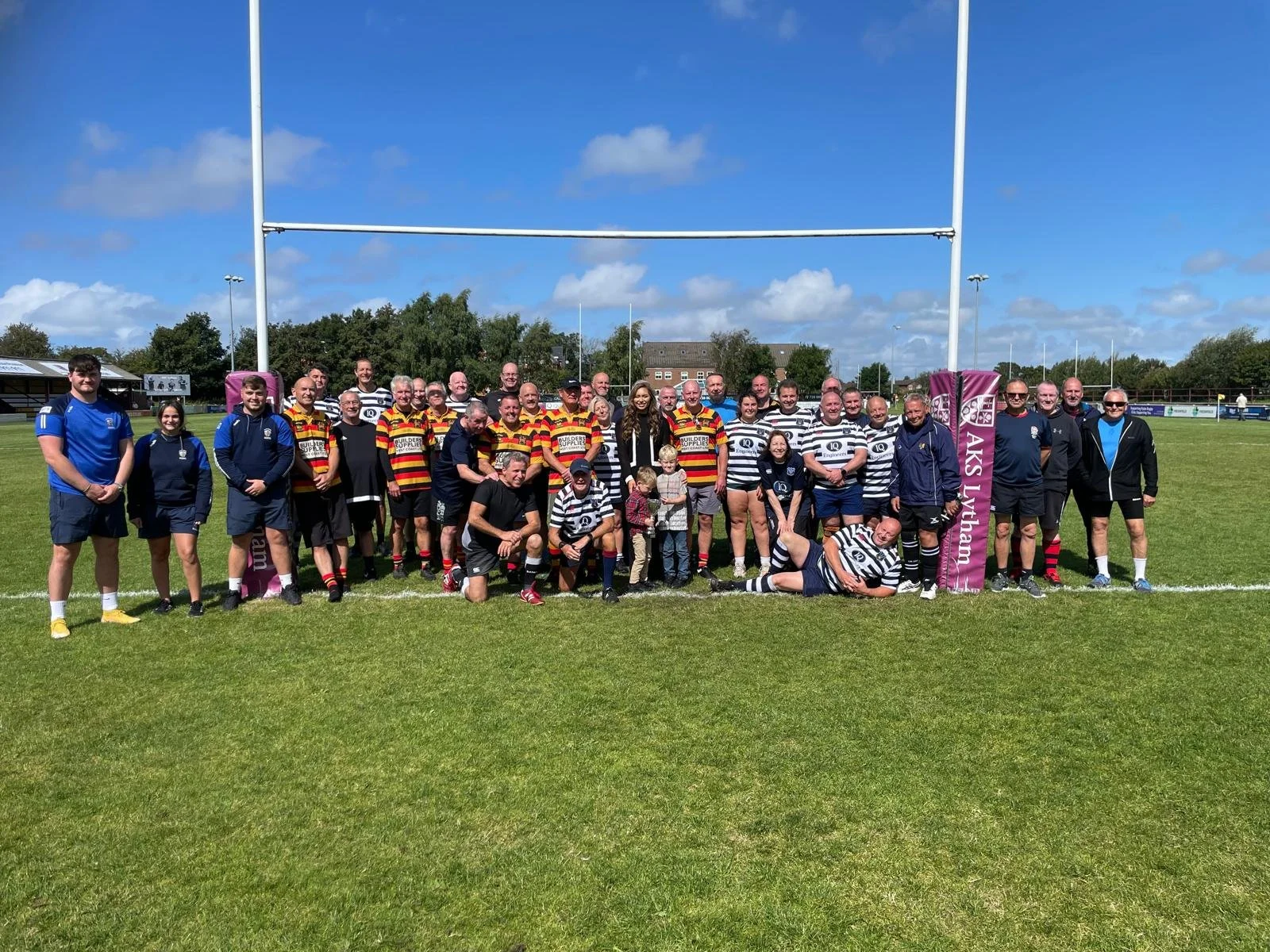We Welcome Fylde and Blackpool outfit, Thornton, to Pocklington for a three team Round Robin of WTR : Saturday 19th October at Percy Road
Games are of two halves of 7 minutes, and the day kicks of at 11am with the following ties:
11am: Pocklington v Fylde pitch one, Thornton v Pock Baba’s pitch 2
11.30 (approx) : Fylde v Thornton pitch one, Pocklington v Baba’s pitch 2
12.00pm Pocklington v Thornton pitch one, Baba’s v Fylde pitch 2
1.00pm !st Place v 2nd Place.
Scores will be as follows:
3 for a win
1 for a draw
Score 4 or more tries 1 bonus point
Loose by less than 4 1bonus point
Walking Rugby: Officiating.
We want everyone to enjoy walking rugby, especially in this context of a friendly round robin. We are looking to forge a positive relationship for years to come with our friends from over the border, and encourage as many Yorkies as possible to take up the game.
So here are some guidelines and interpretations for the day:
The tackle area is contentious, and Ref’s will be insisting that the tackled person comes back to where they were touched.
Rolling substitutions will be allowed
Bad sportsmanship will be penalised.
Walking Rugby is a simplified version of Rugby for ex-players, injured players and non-players of all ages, abilities and gender who enjoy an active and passing game using a rugby ball. The object of Walking Rugby is for two teams of up to seven players to score more tries than the opposing team by passing the ball backwards or lateral and carrying the ball over the opposition’s try-line, according to the guidelines of the game, its sporting spirit and fair play. Walking is defined as moving by lifting and setting down each foot in turn, never having both feet off the ground at once.
1. The Pitch - Pitch size: depends on number of players per team.
a. Suggestion: allow 5 to 7 metres width per player.
b. Pitch to be square or even wider than long depending on mobility and skills of players (maximum width 40 metres and maximum length 30 metres).
c. Indoors in winter: a sports hall would be ideal if possible or Astro turf.
2. Match Ball - Size 4.
3. Teams - Each team shall have no more than seven players in the playing area during play.
a. For playing numbers of 6 or more-a-side, teams may agree to implement uncontested scrums.
b. If extra players are available, then substitutes can be employed so that all can be involved. Substitution on the sidelines must wear bibs and can only be made when play has stopped and the referee informed.
4. Playing Clothes - Team members should all wear a sports strip or sports bibs that identify them as one of the team. Jewelry, etc. must be removed or covered. Suitable footwear for the playing surface should be worn.
5. Time - A game consists of:
a. Two halves each of seven minutes, unless agreed otherwise beforehand.
b. A half time interval will be up to two minutes.
6. Match Officials - The referee, if present, is the sole judge of fact and law.
a. A neutral referee is highly desirable.
b. Otherwise, refereeing by a team member or self-refereeing may be necessary.
c. The nominated team captain on the pitch may converse with the match referee .
7. Advantage - If a team gains a clear and real advantage following an infringement by their opponents and the ball has not gone to ground, the referee may allow play to continue in an effort to keep the game flowing.
8. Score - A try is scored when the ball is carried by an attacking player over the opposition try-line from in-field with both feet on or over the try-line before the player is tackled. A penalty try will be award if offences by an opposition player prevents a try being scored.
9. Foul Play - The following are considered foul play and appropriate action shall be taken for repeat offenders or repeat offences. Where a try would otherwise have been scored a Penalty Try should be awarded.
a. A deliberate knock-down by a defender.
b. Offside and interfering with play.
c. Defenders preventing the ball carrier making a pass after a tackle.
d. Over-robust tackle or tackle above the shoulders.
e. The Ball carrier must not hand off or drop shoulder into or back into or walk straight at the tackler.
f. Snatch/rip the ball from the ball carrier.
g. Repeat offences should be punished with:
i. Temporary exclusion (2 minutes duration) - Yellow Card.
ii. Permanent exclusion (for the remainder of the game) - Red Card.
10. Offside and onside in Open Play - A tackle, touch, scrum, penalty or turnover sets an offside line one metre for a tackle and three metre for scrum, touch, penalty or turnover closer to the offenders try-line at that point parallel to the try-lines.
a. An offside player must not interfere with play – Penalty.
b. An offside player can only be put on side by:
i. Retiring behind the off-side line.
ii. An onside team-mate of that player moves past the offside player within the playing area.
Open Play – All players in open play are onside until a tackle or an offence has occurred, any onside player can intercept a pass or tackle a player from any position in open play.
11. Knock on – A knock on can occur anywhere in the playing area.
a. If the ball is knocked on or dropped by the attacking team – turnover or scrum.
b. A deliberate knock-on and the ball hits the ground – Penalty (but a knock up and catch by the same player (interception), play on unless tackled).
12. Starts and Restarts – At the start of a half and after a score, play starts with a tap and pass at the centre of the pitch.
a. After a score the re-start is by the team that did not score.
b. All defenders must be three metres back from the centre line.
c. On-side defenders may advance once the ball has been tapped by the ball carrier.
13. Player or Ball to Ground -
a. Player going to ground – referee must stop play – restart with tap and pass to team in possession.
b. Ball hitting the ground:
i. Ball goes backwards to ground – turnover to non-offending team.
ii. Ball goes forwards to ground – scrum to non-offending team.
14. Tackle – A defending player can arrest an attack with a simultaneous two-handed touch to the ball-carrier to the area between the shoulders and the waist including the torso and arms of the attacker (a tackle).
a. A tackle sets an off-side line which is one metre from the point of tackle, parallel to the try-lines.
b. When tackled, the ball-carrier must pass the ball correctly within one pace.
c. When tackled, the ball carrier must pass the ball correctly without delay (i.e. within three seconds unless impeded).
d. When tackled, ball carrier must retreat to point of tackle if they travel more than one pace (travelling).
e. Defenders must not prevent the ball carrier making a pass after a tackle.
f. A defending player who is offside and interfering with play should be penalised unless advantage to the non-offending team applies.
g. An over-robust tackle must be penalised.
h. A hand-off is not allowed, nor is walking straight at or backing into a defender.
i. A defender shall NOT attempt to take the ball from the ball carrier (snatch/rip).
15. Turnovers: - A turnover shall be awarded for any of the following, and for scrum offences if playing with less than 6 a side:
i. Ball hitting the ground, but not a knock on. Re-start from point where ball hit ground.
ii. Ball going or carried into touch. Re-start from touchline.
iii. Delayed pass after a tackle (unless impeded by a defender).
a. The turnover must be taken at the point of the offence indicated by the referee.
b. A turnover is taken by tapping the ball with the thigh, knee or foot and passing.
c. As soon as the ball carrier has tapped the ball the on side defenders may advance.
d. The turnover may be taken quickly.
e. At a turnover, the off-side line is three metres closer to the offender's try-line.
f. No turnover shall be taken closer than three metres from a try-line by either attack or defence.
g. All defenders in front of the off-side line must retreat.
h. If an offside defender interferes with the taking of the turnover, then a Penalty will be awarded.
16. Touch: - If the ball or ball-carrier goes into touch a turnover is awarded.
a. A touch sets an off-side line three metre closer to the offenders’ try-line at the point of touch, parallel to the try-lines.
17. Scrums - Uncontested scrums will only be played if there are at least six players in each team and both teams agree. Otherwise, a scrum offence will be treated as turnovers. A scrum will be awarded for any of the following:
i. Forward pass.
ii. Ball hitting or touching a player and going forward.
iii. Dropped ball or knock on.
iv. Ball passed back, hitting referee.
v. Accidental crossing / obstruction.
a. A scrum will be a minimum of three metres from any boundaries of the playing area (try and touch lines); when the scrum is three metres from the try-line, the defending team’s offside line is the try-line.
b. The scrum will be uncontested, i.e. no pushing and no striking for the ball by the defending team.
c. The following applies for scrums:
i. Three closest players from each side will make up the scrum with one of them being the scrum half.
ii. Both teams shall have a scrum half.
iii. The non-offending team’s scrum half feeds ball, then passes out or attacks.
d. The non-offending team’s scrum half will choose which side to feed the ball and the ball will be fed from the midpoint of the scrum. The scrum half must be the one to make the pick-up from the back of the scrum.
e. At a scrum:
i. the non-offending team’s offside line will be behind the rear feet of their scrum.
ii. the offending team’s offside line will be three metres back from the rear feet of their scrum.
f. Players in the scrum are to remain bound in the scrum and the offending scrum half will remain at or behind the midpoint of the scrum until the referee calls “Scrum Over”.
18. Penalty – A penalty will be awarded for:
i. A player running at any time during a game, with or without the ball.
ii. Illegal pass e.g. ball handed on.
iii. Defender preventing the ball carrier making a pass after a tackle.
iv. Defender failing to retire one metre after a tackle and influencing play.
v. Hand-off, or dropping shoulder or backing into the tackler by the ball carrier.
vi. Over-robust or high tackle.
vii. Offside and interfering with play.
viii. Deliberate knock-on and ball hits the ground.
ix. Defender failing to retire three metres at a penalty or turnover.
x. After a tackle, ball carrier not retreating to point of tackle if they travel more than one pace (travelling).
xi. Pushing or defender striking in the scrum.
xii. Defending scrum half moving past the midpoint of the scrum before “scrum over” is called.
xiii. Deliberate obstruction.
xiv. After a tackle, within one metre of the try-line, the ball carrier not stepping back a minimum of one metre from the try-line before passing the ball.
a. A penalty shall be taken at the point of the offence indicated by the referee.
b. No penalty shall be taken closer than three metres from a try-line by either attack or defence.
c. The penalty taker must tap the ball with his thigh, knee or foot and may then walk or pass.
d. Once the ball has been tapped, on-side defenders may advance.
e. The penalty may be taken quickly.
f. At a penalty, the off-side line is three metres closer to the offender's try-line.
g. All defenders in front of the offside line are offside and must retreat to an onside position.
h. If an offside defender interferes with the taking of the penalty, then a further three metre advance should be imposed.
19. In Goal
a. When the ball-carrier is tackled before the try-line and travels over the try-line (in goal), the ball-carrier must step back into field of play to at least one metre line from try-line before passing – penalty.
b. When the ball-carrier is tackled behind their own try-line (in goal) or makes a forward pass from behind their own try-line (in goal) – scrum (or turnover) three metres in from the try-line from the point of the offence.



